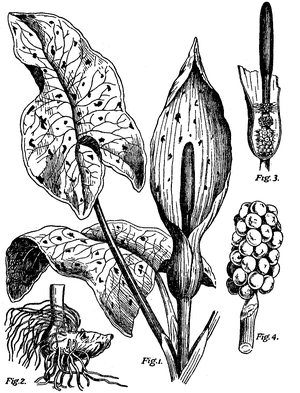

In botany, a spadix (/ˈspeɪdɪks/ SPAY-diks; pl.: spadices /ˈspeɪdɪsiːz/ SPAY-dih-seez, /speɪˈdaɪsiːz/ spay-DY-seez) is a type of inflorescence having small flowers borne on a fleshy stem. Spadices are typical of the family Araceae, the arums or aroids. The spadix is typically surrounded by a leaf-like curved bract known as a spathe. For example, the "flower" of the well known Anthurium spp. is a typical spadix with a large colorful spathe.
In this type of inflorescence, peduncle is thick, long and fleshy, having small sessile unisexual flowers covered with one or more large green or colourful bracts (spathe). Spadix inflorescence is found in colocasia, aroids, maize and palms (palms have compound spadix).
Monoecious aroids have unisexual male and female flowers on the same individual and the spadix is usually organized with female flowers towards the bottom and male flowers towards the top. Typically, the stigmas are no longer receptive when pollen is released which prevents self-fertilization.
In the compound spadix inflorescence, the axis is branched. Usually the whole inflorescence is covered by a stiff boat-shaped hood, for example the coconut (palms).
Gallery
-
 Elephant ear or ape flower (Xanthosoma sagittifolium) with a white spadix partially surrounded by a green-, rose-, and cream-colored spathe
Elephant ear or ape flower (Xanthosoma sagittifolium) with a white spadix partially surrounded by a green-, rose-, and cream-colored spathe
-
 Anthurium scherzerianum inflorescence with spathe and spadix
Anthurium scherzerianum inflorescence with spathe and spadix
-
 Spadix of Spathiphyllum floribundum
Spadix of Spathiphyllum floribundum
-
 Titan arum (Amorphophallus titanum) spadix at the United States Botanic Garden
Titan arum (Amorphophallus titanum) spadix at the United States Botanic Garden
-
Flamingo Lily (Anthurium andraeanum) at the United States Botanic Garden
-
 Jack in the Pulpit (Arisaema triphyllum) in the Allegheny National Forest, Pennsylvania)
Jack in the Pulpit (Arisaema triphyllum) in the Allegheny National Forest, Pennsylvania)
-
Calla lily (Zantedeschia aethiopica) in Funchal, Madeira
-
Spadix of Spathiphyllum in Brazil
-
 Spadix of Typha latifolia
Spadix of Typha latifolia
-
 Spadix of Zantedeschia elliottiana cultivar showing male flowers above with pollen and female below
Spadix of Zantedeschia elliottiana cultivar showing male flowers above with pollen and female below
-
 Peace lily (Spathiphyllum cochlearispathum) clearly showing the characteristic spadix and spathe of the genus
Peace lily (Spathiphyllum cochlearispathum) clearly showing the characteristic spadix and spathe of the genus
-
 Spadix of ZZ plant (Zamioculcas zamiifolia) with curled back spathe
Spadix of ZZ plant (Zamioculcas zamiifolia) with curled back spathe
References
- spadix. CollinsDictionary.com. Collins English Dictionary - Complete & Unabridged 11th Edition. Retrieved October 18, 2012.
Further reading
- Sonderman, Barbara (September 12, 2013). "What is a 'Spathe & Spadix', you ask? Might I find one in the Tucker Greenhouse?". Tucker Greenhouse, Division of Biological Sciences, University of Missouri.
- Ito-Inaba, Yasuko; Sato, Mayuko; Masuko, Hiromi; Hida, Yamato; Toyooka, Kiminori; Watanabe, Masao; Inaba, Takehito (2009). "Developmental changes and organelle biogenesis in the reproductive organs of thermogenic skunk cabbage (Symplocarpus renifolius)". Journal of Experimental Botany. 60 (13): 3909–3922. doi:10.1093/jxb/erp226. PMC 2736897. PMID 19640927.